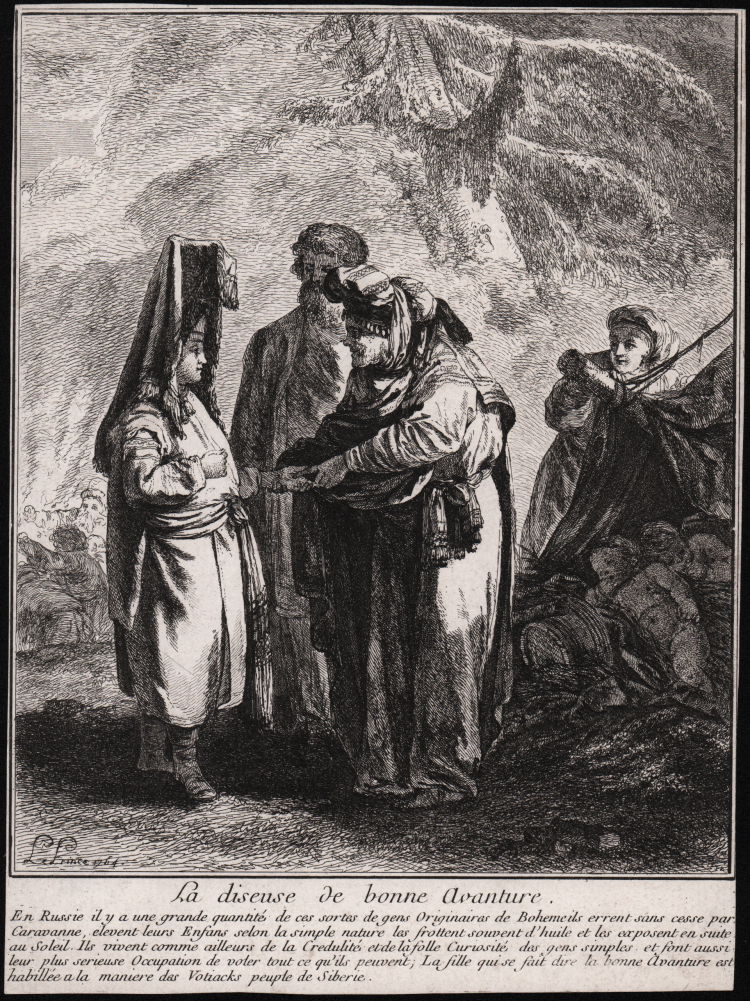



| Reference: | S42000 |
| Author | Jean Baptiste le PRINCE |
| Year: | 1764 |
| Measures: | 160 x 215 mm |


| Reference: | S42000 |
| Author | Jean Baptiste le PRINCE |
| Year: | 1764 |
| Measures: | 160 x 215 mm |
Etching, 1764, signed and dated at lower left; lettered with title followed by five lines of French inscription.
From the Divers ajustements et usages de Russie, a series of ten plates on Russian costumes, designed from life by Le Prince. Plate 2: an old Russian woman reading the palm of a young woman wearing a tall headdress; a bearded man stands beside them; before number.
Le Prince arrived in Saint Petersburg in 1757, and went on to travel throughout Russia over the succeeding five years. Eager to establish his reputation when he returned to Paris he began to paint landscapes and genre scenes, and to make etchings of the Russian countryside and daily life. He became very successful and was a pioneer of the aquatint process, indeed six of the images contained within this collection have an aquatint ground.
A fine impression, printed con contemporary laid paper, trimmed to the platemark, very good condition.
Bibliographic references
Hédou 1879 / Jean Le Prince et son oeuvre (14.I); IFF / Inventaire du Fonds Français: Bibliothèque Nationale, Département des Estampes (10).
Jean Baptiste le PRINCE (Metz 1734 - S.Denis 1781)
|
An important French etcher and painter. Le Prince first studied painting techniques in his native Metz. He then travelled to Paris around 1750 and became a leading student of the great painter, François Boucher. In 1758 Le Prince journeyed to Russia to work for Catherine the Great at the Imperial Palace, St. Petersburg for five years. When Le Prince returned to Paris in December, 1763, after travelled extensively throughout Finland, Lithuania and even Siberia, he brought with him an extensive collection of drawings which he employed as the basis for a number of fine paintings and etchings, and was elected a full member of the Académie de peinture et de sculpture in 1765. Le Prince's graphic art of Russia and its peoples is significant in that he based his compositions entirely upon his own designs, lending a much more realistic portrayal to his views than other eighteenth century contemporaries. He is also credited with being the first artist (in 1768) to introduce aquatint into his etched and engraved plates. He may even have been the inventor of aquatint, the tonal graphic art that would later be so skillfully used by such masters as Goya, Louis-Philibert Debucourt, Delacroix and Thomas Rowlandson.
|
Jean Baptiste le PRINCE (Metz 1734 - S.Denis 1781)
|
An important French etcher and painter. Le Prince first studied painting techniques in his native Metz. He then travelled to Paris around 1750 and became a leading student of the great painter, François Boucher. In 1758 Le Prince journeyed to Russia to work for Catherine the Great at the Imperial Palace, St. Petersburg for five years. When Le Prince returned to Paris in December, 1763, after travelled extensively throughout Finland, Lithuania and even Siberia, he brought with him an extensive collection of drawings which he employed as the basis for a number of fine paintings and etchings, and was elected a full member of the Académie de peinture et de sculpture in 1765. Le Prince's graphic art of Russia and its peoples is significant in that he based his compositions entirely upon his own designs, lending a much more realistic portrayal to his views than other eighteenth century contemporaries. He is also credited with being the first artist (in 1768) to introduce aquatint into his etched and engraved plates. He may even have been the inventor of aquatint, the tonal graphic art that would later be so skillfully used by such masters as Goya, Louis-Philibert Debucourt, Delacroix and Thomas Rowlandson.
|